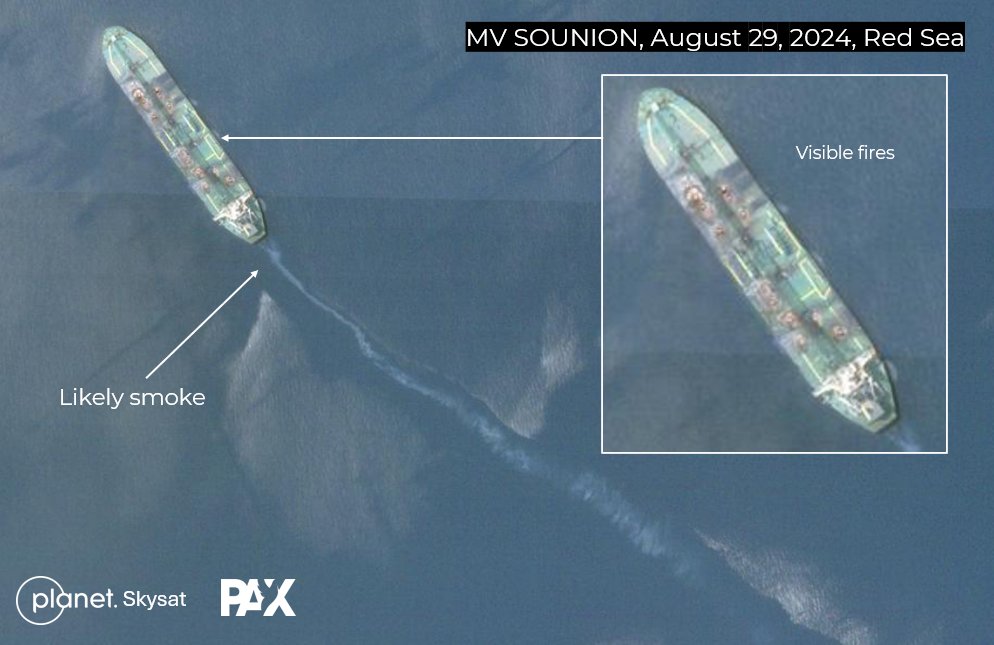Dieses Video zeigt angeblich die Explosion und das Feuer danach auf der Sounion. Der Tanker wurde von den Huthi beschossen, die Seeleute evakuiert.
— Deutsche Seemannsmission ⚓️ support of seafarers (@DSM_Seeleute) August 23, 2024
Es ist viel Öl an Bord… eine Umweltkatastrophe droht
pic.twitter.com/pypM4N9ig6
Three simultaneous detonations occur at evenly-spaced locations on Sounion's main deck
(Courtesy Houthi Military Media)
From Maritime Executive by
Two days after Houthi forces blew up the cargo tanks of the Greek-owned Suezmax Sounion, the flames emerging from the vessel's deck were still visible from space, based on imagery from the EU's Sentinel satellite system.
Western governments have warned that the terrorist group's action could cause a devastating oil spill in the Red Sea, up to four times larger than the Exxon Valdez disaster - with serious consequences for the environment and for subsistence fisheries.


A possible oil spill stretching 2.2 nautical miles in length was spotted in a location matching the Sounion tanker, after the vessel caught fire following an attack by Yemen’s Houthi rebels in the Red Sea earlier this month.
Bloomberg graphics
"While the crew has been evacuated, the Houthis appear determined to sink the ship and its cargo into the sea," said the U.S. State Department in a statement.
"Through these attacks, the Houthis have made clear they are willing to destroy the fishing industry and regional ecosystems that Yemenis and other communities in the region rely on for their livelihoods, just as they have undermined the delivery of vital humanitarian aid to the region through their reckless attacks."
New satellite imagery from @ESA_EO Sentinel-2 shows burning oil tanker SOUNION at the Red Sea. Unclear how much oil is spill due to sun glint on the water. pic.twitter.com/volel0BKmr
— Wim Zwijnenburg (@wammezz) August 25, 2024
The European Union's naval mission in the Red Sea, EUNAVFOR Aspides, echoed these concerns.
"This situation underlines that these kinds of attacks pose not only a threat against the freedom of navigation but also to the lives of seafarers, the environment, and subsequently the life of all citizens living in that region," the EU mission said in a statement.
Before the blast, multiple Houthi observers aimed video cameras at the vessel from different angles (below).
"This situation underlines that these kinds of attacks pose not only a threat against the freedom of navigation but also to the lives of seafarers, the environment, and subsequently the life of all citizens living in that region," the EU mission said in a statement.
Before the blast, multiple Houthi observers aimed video cameras at the vessel from different angles (below).
Based on their footage, the tanker was wracked by three simultaneous explosions, and three fireballs erupted from the main deck level upwards.
The pattern suggests that after they disabled the Sounion, the Houthi attackers waited for Western defenders to leave, then boarded the tanker, placed explosive charges on deck, and recorded the ensuing detonation for public release - as they have done previously.

Pictured from the UN report on the FSO Safer, whose precarious circumstances were very similar to the Sounion’s, are maps showing the areas at risk by using colours to indicate how much oil is expected on the surface in different places and times. Ports are marked with black dots, and water treatment plants are marked with blue dots.
A spokesman for Houthi forces did not address potential environmental harm from the attack, and said only that the vessel was targeted because of the shipowner's alleged decision to continue sending vessels to Israeli seaports.
The Houthi militia has declared a naval blockade on Israeli-affiliated shipping because of the ongoing military operation in Gaza, though it has previously attacked vessels without any clear Israeli nexus - including vessels linked to Houthi allies.
Links :
Links :
- Maritime Excecutive : Houthis claim first launch of hypersonic missile targeting distant MSC ship / Houthis hit another merchant ship with a bomb boat / Are we letting the terrorists win
- Safety4Sea : Fears for extensive oil spill rise after Red Sea tanker attack / Houthis are launching more sophiticated attacks
- Splash : Red Sea littoral states brace for the worst tanker spill this century
- Bloomberg : Potential oil spill spotted near stricken tanker, Greece says
Maritime Executive : Salvors Due to Reach Burning Tanker Sounion in the Red Sea
ReplyDeleteMaritime Executive : Houthis Step Up Attacks After Denying Iran’s Statement Last Week of Pause
ReplyDeleteMaritime Executive : Conditions Not Met to Tow Burning Tanker in Red Sea Says EU
ReplyDeleteMaritime Executive : Talks Continue Over Tanker Burning in Red Sea as U.S. Releases Video
ReplyDeleteBBC : Disaster averted in Red Sea as burning tanker saved
ReplyDelete